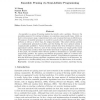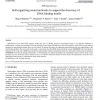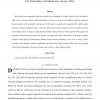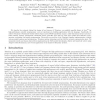8575 search results - page 1648 / 1715 » A Model of Learning Using the Internet |
JMLR
2006
14 years 9 months ago
2006
An ensemble is a group of learning models that jointly solve a problem. However, the ensembles generated by existing techniques are sometimes unnecessarily large, which can lead t...
NN
2006
Springer
14 years 9 months ago
2006
Springer
Identification of the short DNA sequence motifs that serve as binding targets for transcription factors is an important challenge in bioinformatics. Unsupervised techniques from t...
PAMI
2006
14 years 9 months ago
2006
Real-world action recognition applications require the development of systems which are fast, can handle a large variety of actions without a priori knowledge of the type of actio...
SIGIR
2008
ACM
14 years 9 months ago
2008
ACM
Evaluation measures act as objective functions to be optimized by information retrieval systems. Such objective functions must accurately reflect user requirements, particularly w...
IJHPCA
2007
14 years 9 months ago
2007
We describe the rationale behind the design of key features of Titanium—an explicitly parallel dialect of JavaTM for high-performance scientific programming—and our experienc...




